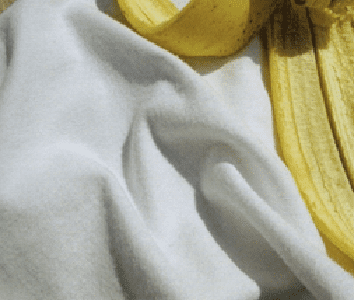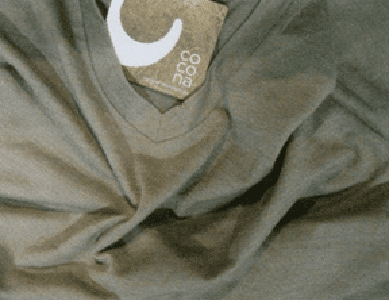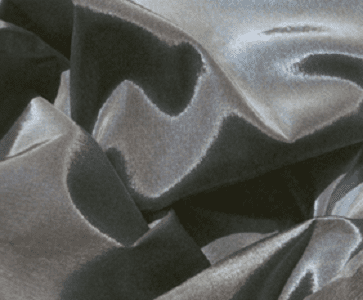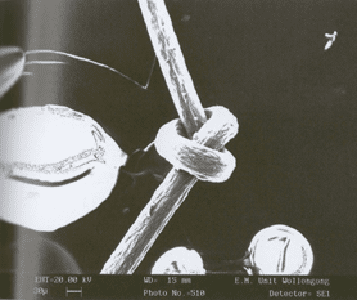EVOLVING FIBRES AND YARNS
For thousands of years all of the fibres used to make cloth were natural fibres. Now, almost half of the fibres produced in the world are synthetic fibres made from tress, oil and natural gas. It is basically broken down to: Cotton (45%), Synthetics made from oil and natural gas (36%), Jute and Synthetics made from tress (6%), Wool (5%) and all other natural fibres (2%).Most of this change has taken place in the last 50 yrs. Developments in fibre and yarn technologies are having an impact on both natural and synthetic materials. Fibre engineers are creating fibres that combine the benefit of both, sometimes even bringing them together literally to form hybrids. Performance is enhanced by the handle and comfort associated with natural fibres, while natural fibres are engineered to be as easy care as artificial fibres. These synthetics and hybrids are far removed from the original ‘artificial silk’ rayon which in reality had nothing like the handle and lustre of the natural fibre it purported to re-create. While the original synthetics were poor imitations of more expensive natural materials, the engineered fibres that we are seeing today are much more highly valued in every sense.
One of the most significant changes to occur in the textile industry has been the attitude. Research and development laboratories no longer try to imitate nature; instead they look to combine the finest qualities of natural and man-made while seeking out their own aesthetics and benefits for the consumer. As new production techniques become available, the opportunities for engineering fibres and yarns stretch from large-scale to the nano, invisible to the naked eye.
The extent to which fibres and yarns can now be engineered is allowing for a dramatic increase in the development of fibres for wellness, health and protection. In this article we take a look at the evolving fibres and yarns from different parts of the world.
HYBRID FIBRES
Environmental concerns are encouraging many manufactures to focus on the use of a single fibre within their yarns; developments in engineered fibres are making this more achievable. However, there are still and will remain reasons for bringing different qualities of fibres together: particularly for performance, health and safety reasons. A category of hybrid compounds is starting to emerge. Thought not a fibre in the conventional sense, they most closely resemble a yarn or fibre in that they contain a central textile component and because of the manner in which they are used.
UK based Speciality Fibres and Materials Ltd., uses melt spinning process to melt thermoplastic polymer chips. From this they make precision yarns in medicine. They incorporate barium sulphate (crystalline solid use to provide radio contrast in X-rays) into polypropylene yarn. Micropake is an X-ray detectable yarn that can be used in woven and nonwoven products such as surgical gauze. The yarn contains 60% barium sulphate. The crystalline solid is insoluble in water and would be extremely difficult to apply to a yarn using more conventional coating or finishing processes. They also make highly absorbent and gelling calcium alginate fibres which are manufactured from sodium alginate extracted from seaweed. Calcium alginate is used worldwide in the production of wound dressings where the principle of a moist wound environment encourages more effective healing.
| A routine X-ray can easily detect the barium sulphate within the multifilament yarn which runs through the swab |
| Yuxin woven polyester geogrid, Shandong Shenghao Fibreglass Co. Ltd, China. The company use both polyester and glass fibre in their range of geogrids with yarn coatings that include bitumen and PVC. The fabric is used for reinforcement in roads, railways and bridges. |
Multi-axial weave, RWTH Aachen, Germany.
Two different glass fibres have been used in this weave. The material is used for industrial applications where high strength and flame retardancy are required.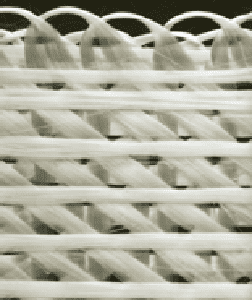
The Swiss-based Schoeller Spinning Group produces a number of aramid- based hybrid fibres. They use Kevlar, Panox, glass filament and viscose in various combinations and permutations. The combinations of these fibres in various percentage means that the resulting yarn has the cut and abrasion resistance and heat protection required to make clothing for fire-services, motorcyclists, backing for aluminized protective suits and cut-resistant protective clothing.
COATED FIBRES AND YARNS
While majority of coatings and treatments are applied to the finished fabric, there is an increasing trend to apply these treatments to fibres and yarns. This is generally for high performance and specialist applications, but as costs come down there is likely to be an increase in demand and availability.
Bekinox LT, Bekaert, Belgium.
These slivers of stainless steel fibres can be used on their own or combined with other fibres for anti-static applications such as carpets.
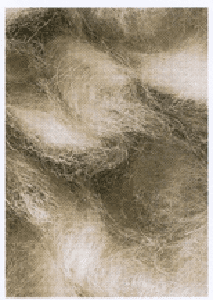
| Scotchlite yarns, 3M, USA. Available as tapes and fabrics for years, 3M are now manufacturing Scothlite in yarn, including coloured form. It is retro-reflective due to the coating of miniature glass beads around the fibre that reflects incoming artificial light back to the source.
|
The Schoeller Spinning Group is responding to the demand for comfort combined with high performance in their development of a wool and stainless steel yarn for anti-static clothing. The yarn in cross-section shows 92% Merino wool randomly interspersed with 8% Inox stainless steel fibre. The yarn can be easily dyed and knitted and is capable of being finished with treatments such as Teflon without interfering with the shielding performance. The ability to combine several capabilities in a single yarn is relatively new. Less than a decade ago this would not have been possible without reducing, or even destroying, the performance of one or both functionalities.
Nanocoatings have made progress largely in fabrics, but are starting to appear on the individual fibres. Researchers at Cornell University’s Textiles Nanotechnology Laboratory have developed a way of coating fibres with polyelectrolytes, inorganic and metallic nanolayers, to develop specialist high-performance and smart materials. Developments include, cotton coated with silver and gold nanoparticles to produce an anti-bacterial yarn that destroys bacteria and reduces the need for washing. They have also coated nylon nanofibres with gold nanoparticles and anomalous crystal formations of NaC(R) for potential applications in the active filtration of hazardous gases and toxic chemicals as well as anti-counterfeiting devices.
Researchers at Georgia Institute of technology are looking into ways to optimize the collection of solar energy. The majority of systems rely on flat panels directed at the sun either as static systems or capable of rotating to follow the direction of the sun’s rays. At Georgia, they are researching how to create a Photovoltaic (PV) fibre that can be woven into the membrane. To achieve this, they are nanocoating fibre optics with a dye-sensitized PV coating. The cladding of the fibre optic is removed and replaces with a conductive coating and seed layer of zinc oxide. Zinc oxide nanowire is then grown on this prepared surface so that the result is a coating of fur nanowires. This is coated with a dye-sensitized PV material before being immersed in liquid electrolyte to collect current from the PV reaction. The ends of the fibre are directed at the sun: light enters the unclad fibre optic carrying it along and through the wall to the nano PV so that it covers a very large area. Researchers are confident that it will prove much more efficient than conventional systems of collection.
Sweden’s Swerea IVF is developing a process of coating microfibers with nanofibres. The aim is to use fibres to create scaffolding for tissue engineering based on the principle of collagen.
TECHNONATURALS
Much of the technology of the technonaturals has been driven by the apparel market. Lessons have been learnt from development of health-giving, highly engineered fibres in the 1990’s when performance was high but tactile qualities were low. In combining natural with synthetic or creating hypernaturals, these new yarns look to combine the best of both worlds, delivering performance with good tactile qualities.
| Banana cotton fabric, Technical Fabric Services (TFS), Australia. Banana fibres in textiles offer sustainable product that is highly absorbent. Fibres are extracted from the bark of the plant and then combined with cotton and elastane for comfort and stretch in fabrics for intimate apparel. |
Cocona fibre. Cocona Inc, USA, 2009.
Cocona activated carbon is manufactured from coconut waste and absorbs odour and offers UV protection. It is not depleted during washing or wearing because it is embedded in the fibre.
The Lenzing Group’s key product is lyocell, a cellulose fibre made from wood pulp sold under the trade name Tencel. The wood pulp is converted into nanofibrils using nanotechnology so that the result is an exceptionally fine yarn that offers high moisture management with good tactile properties. Tencel absorbs excess liquid and then quickly releases it into the atmosphere to help to keep the body at a comfortable temperature. This function carries an additionally anti-bacterial benefit because, since excess water is moved away from the skin, bacteria have less opportunity to grow. When it is used in conjunction with aramid fibres, it provides high fire protection with comfort, especially important in firefighting workwear where clothing has to be worn for prolonged periods of time under stressful conditions.
Smartfiber AG produce a lyocell fibre, SeaCell, with enhanced health properties. It uses seaweed as an active ingredient in the lyocell fibre. Seaweed has long been used in Chinese medicine and is recognized as offering protection for the skin; it also contains anti-inflammatory properties. There is what is termed an ‘active exchange’ between the fibre and the skin. The company describes how there is an exchange of substances between the fibre and the skin with nutrients such as calcium, magnesium and vitamin E released by the body’s natural moisture when a garment using the fibre is worn. Algae are particularly good at absorbing metal. This has prompted a second version of the fibre, SeaCell active plus, which sees silver ions added for anti-bacterial benefits. Seaweed forms the basis for a new range of wound dressings that are highly absorbent, encouraging faster healing.
Advanced production processes are making it possible to work with non-textile materials to convert them into yarns. This has the advantage of combining flexibility of a yarn with the performance of ceramic and metals. Smartcel Ceramic is made by Smartfiber AG and brings together cellulose and ceramic resulting in a 100% ceramic fibre. The Smartcell Ceramic can be produced in different forms including hollow and spiral structures; the choice driven by the end application. A sintered PZT ceramic fibre has the ability to stretch when exposed to alternating voltage-producing soundwaves in the process. This gives it application in ultrasound products such as sonar systems for locating obstructions and medical imaging.
Andreas Lendlein (mNemoscience, Germany), 2002. Sequence of images showing the world’s first ‘intelligent’ suture tying itself into a knot within 20 seconds when it is exposed to 41˚c. In 1997, while working at MIT, Lendlein developed a shape memory polymer that would respond to body temperature. Shape memory materials can memorize a permanent shape and are automatically transformed into this permanent shape when exposed to a suitable external trigger such as body heat. Lendlein sutures are designed for keyhole surgery and are made from polymeric material that encourages tissue renewal and biodegrade naturally within the body. The sutures are now being developed for commercial production. mNemoscience is currently working on light-sensitive shape memory materials.
Sequence of images showing the world’s Waterborn synthetic upholstery fibre
first ‘intelligent’ suture
Waterborn is a new synthetic fibre upholstery fabric manufactured almost entirely without the use of organic solvents. It was developed by Kvadrat in close co-operation with a leading fibre producer in Japan. Organic solvents were avoided by using polyurethane dispersed in water to impregnate a non-woven fabric made of polyester and nylon. By heating the fabric, the polyurethane covers the fibres, creating a composite fabric. As a result, organic solvent emissions are reduced to approx 8% of conventional production emissions. The surface qualities of Waterborn were designed by French architect Jean Nouvel.
NANOTECHNOLOGY
Nanotechnology is at a relatively young stage of development with much of the work still at research stage. It is a field of material design where the smallest man-made devices encounter the atoms and molecules of the natural world ( for comparative purposes, a nanometre is a billionth of a metre, the diameter of an atom is about a 1/ 4 of a nanometre, the average diameter of a human hair is 10,000 nanometres). Advances are being made in many areas such as the production of high-strength carbon nanotubes, but scale and the cost of production still have to be overcome in order to make it a viable manufacturing process. Nanotubes are tube-shaped material made from carbon atoms bound together to create a stiff structure that forms the strongest existing bond. Nanotubes are good conductors for heat and electricity. They are sub-microscopic carbon fibres and are light, strong and very flexible, although each one is only 10 -50 nanometres in diameter.
| Morphotex, Teijin Ltd, Japan. The inspiration for the fibre comes from the Morpho butterfly which uses optic effects to provide protective camouflage in the Amazon rainforest. This fibre is produced using nanotechnology |
| Carbon nanotubes. Developed by a research team led by Gordon Wallace from Australia’s Commonwealth Scientific and Research Organization (CSIRO)’s Division of Textile and Fibre. |
FUTURE
In the future, the fibres we use will continue to change. Some fibres will go out of fashion, while others will become popular. Scientists will improve existing fibres and create new ones. Some of these changes are already happening. Selected genes have been put into tiny mouse-ear cress plants so that they are able to grow polymers like polyester. Unlike, the polyester from petroleum, however the new plant-grown polymers are biodegradable. This means they can be easily broken down by nature. Soon scientists hope to produce such polymers from corn and potatoes.
| A mouse-ear cress plant, shown actual size | Red areas on this enlarged picture of mouse-ear cress plant show where new polymers have grown |
There are also specially treated fibres that capture heat from the environment or your body. The energy from the heat is held inside the fibres in microcapsules until the temperature drops. Then the microcapsules release the heat, through the fibres and back into the environment.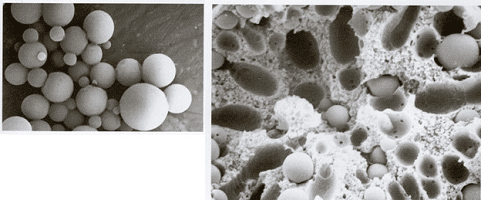
| Enlarged microcapsules. | Inside of a synthetic fibre enlarged 2000 times. One can see several microcapsules nestled in the fibre. |
New spinning technologies are revolutionizing what can be achieved in terms of performance and comfort in fibres and yarns. Electrospinning is yielding some very encouraging results in the productions of nanofibres. Creativity, ingenuity and a passion for fibres and yarns underlie these changes. The innovations that we are seeing are driven by the consumer: by changes in consumer demographics, engagement with the environment and growing awareness of global social responsibility. This is a time of change and change is good. Ten years from now you may be wearing a shirt or pants made of polyester from a potato. Your jacket may store heat during the day and then use that heat to keep you warm at night. Possibilities are endless and they will happen in our near future…
BIBLIOGRAPHY
- Textiles Today a global survey of trends and traditions – chloë colchester
- Advanced Textiles for health and Well-Being – Mari O’Mahony
- Unraveling Fibers – Patricia A. Keeler and Francis X. McCall, Jr.





